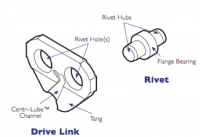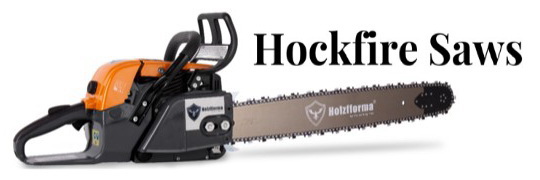Philbert
Chainsaw Enthusiast
- Local time
- 6:50 AM
- User ID
- 737
- Joined
- Jan 30, 2016
- Messages
- 4,998
- Reaction score
- 21,313
- Location
- East Dakota
More About Rivets
At the most basic level, 'mushrooming' the ends of rivets holds a saw chain together, regardless of whether the rivets are peened, or spun, or fed a junk food diet. But rivets do much more!
While the ends ('hubs' in the illustration) are soft and malleable enough to be spun and formed, the center ('hub') is actually hardened and acts like a bearing in the drive link holes. This was demonstrated to me by an engineer conducting quality control tests on chain parts. Exactly how they they get different hardness levels on these tiny parts is magic to me, but I am easily amazed.

'Properly' spinning the rivets not only creates the mushroomed ends, but also expands the diameter of the rivet hubs so that they tightly fill the holes in the tie straps. This way, all of the pivoting movement occurs at the bearing, lubricated by the bar oil. If movement occurs where the softer hubs of the rivets meet the tie straps, this will contribute to excessive wear, and 'chain stretch'.
*BTW - a 'preset' is just a tie strap with the rivets already attached, used on one side of the chain, which makes assembly a lot easier than trying to manipulate tiny rivets. I do not know of any manufacturer than normally sells chain rivets that are not part of a preset.

So, while reusing a rivet, or smashing it with the flat end of an axe, may hold a chain together, it is like driving around on bald tires, or standing on a rickety ladder: it works, until it doesn't. But it is not a 'best practice'.
Philbert
At the most basic level, 'mushrooming' the ends of rivets holds a saw chain together, regardless of whether the rivets are peened, or spun, or fed a junk food diet. But rivets do much more!
While the ends ('hubs' in the illustration) are soft and malleable enough to be spun and formed, the center ('hub') is actually hardened and acts like a bearing in the drive link holes. This was demonstrated to me by an engineer conducting quality control tests on chain parts. Exactly how they they get different hardness levels on these tiny parts is magic to me, but I am easily amazed.

'Properly' spinning the rivets not only creates the mushroomed ends, but also expands the diameter of the rivet hubs so that they tightly fill the holes in the tie straps. This way, all of the pivoting movement occurs at the bearing, lubricated by the bar oil. If movement occurs where the softer hubs of the rivets meet the tie straps, this will contribute to excessive wear, and 'chain stretch'.
*BTW - a 'preset' is just a tie strap with the rivets already attached, used on one side of the chain, which makes assembly a lot easier than trying to manipulate tiny rivets. I do not know of any manufacturer than normally sells chain rivets that are not part of a preset.

So, while reusing a rivet, or smashing it with the flat end of an axe, may hold a chain together, it is like driving around on bald tires, or standing on a rickety ladder: it works, until it doesn't. But it is not a 'best practice'.
Philbert








